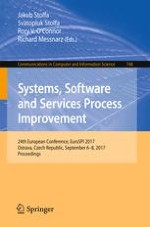2017 | OriginalPaper | Chapter
Lean and Agile Software Process Improvement - An Overview and Outlook
Authors : Alexander Poth, Susumu Sasabe, Antònia Mas
Published in: Systems, Software and Services Process Improvement
Publisher: Springer International Publishing
Activate our intelligent search to find suitable subject content or patents.
Select sections of text to find matching patents with Artificial Intelligence. powered by
Select sections of text to find additional relevant content using AI-assisted search. powered by
